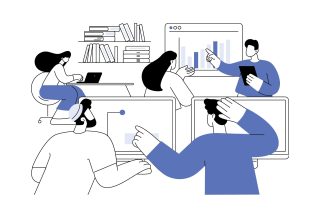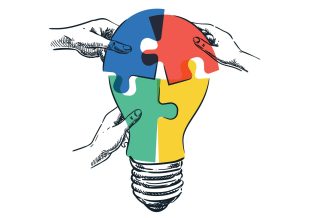FOCUS
One vision, many paths
Personalized learning blends teacher interests with a collective purpose
By Paul Emerich France
Categories: Implementation, Learning designs, PersonalizationAugust 2019
Vol. 40 No. 4
Educators deserve professional learning tailored to their needs, but far too many models for personalization are built on a faulty foundation of myths. Those myths include the assumption that personalization necessitates large investments in technology and the erroneous belief that it must look different for every educator.
These myths make the workload of personalization unsustainable and create divides between teachers instead of the collaboration educators really need. It is important to challenge these myths and develop approaches that honor both the individual and collective. When we do so, we become liberated by balance and have the opportunity to make professional learning meaningful and relevant.
Personalization Myths
People often confuse personalization with individualization. They assume that the more distinct and separate learning is for each individual, the more personalized it will be. This type of thinking leads us to believe that teachers should learn only what they want to and when and where it’s convenient.
The reality is that personalized learning need not be individualized. Instead, it must be meaningful and relevant to any given learner. We usually find meaning and relevance through the opposite of individualization: identifying a greater purpose than ourselves, seeking camaraderie, and making human connections.
Models for personalized professional learning must account for this. Professional learning should be meaningful and relevant to individual teachers in the context of helping all teachers unite in a collective consciousness of professional learning. This enables teachers to collaborate with one another and garner support on personal goals from fellow educators. Personalized professional learning need not be individualized. Instead, it should blend teacher interests with a collective purpose. #LearnFwdTLP Share on X
Unfortunately, this is not what we generally see when we hear about personalized professional learning. We often see teachers turned toward computers, accessing individualized sets of articles or instructional videos. The notion of individualization leads to the presumption that technology must be at the center. Without technology to manage the complexity of individualized goals, courses, and projects, how else would we keep everything organized? This results in educators working on their own passion projects, entirely isolated from a sense of collective purpose or camaraderie.
Professional learning should be meaningful and relevant to individual teachers in the context of helping all teachers unite in a collective consciousness of professional learning.
Personalizing in Three Dimensions
The solution for these misdirected efforts is balance. It is possible to honor individual teachers’ passions and interests while uniting all educators under a collective professional purpose. It is possible if we think of professional learning in three dimensions:
- First dimension: We honor the collective consciousness of a professional learning environment, uniting all teachers under one common vision for teaching and learning.
- Second dimension: We support professional learning in small groups or teams, fostering a collective consciousness and purpose in smaller, more intimate settings.
- Third dimension: We leverage coaching models to nurture the inner dialogues of educators toward professional goals and personal satisfaction.
This is parallel to the way I frame personalized learning for students in three dimensions (France, 2019). In the classroom, we leverage the collective consciousness, small groups, and the inner dialogues of students. In connecting the dimensions for educators and students, we can support educators’ individual learning and help them experience a model of professional learning that they can expand to students.
The three dimensions are not mutually exclusive. Instead, they support one another, which is why it’s important that all three are well-structured and healthy.
The First Dimension: The Collective consciousness
In 1893, sociologist Emile Durkheim developed the concept of the collective consciousness. The collective consciousness refers to the values, beliefs, and knowledge that any given group of people share (Durkheim, 1893). The collective consciousness matters because it is what unites a group of people.
Focusing on this first dimension allows us to pay attention to equity and justice, which must be at the heart of our intentions for learning. All educators must feel they are part of the learning community. Social isolationism is a direct threat to equity.
The collective consciousness of professional development can be defined by various structures, including a clear school vision, professional standards for teaching, and agreed-upon schoolwide initiatives.
A clear school vision gives all educators and leaders guidance for autonomous decision-making. Professional standards for teaching place productive constraints around pedagogy, providing a common language upon which educators can set individualized goals that operate in a relationship with collective goals. Schoolwide initiatives prioritize continuous innovation for all teachers, also promoting collective teacher efficacy in the process (Hattie, 2016). A clear school vision gives all educators and leaders guidance for autonomous decision-making. #LearnFwdTLP Share on X
In addition to running my own classroom, I lead a program for assistant teachers. When building our vision for autonomous and personalized professional learning, we felt it was important for all assistant teachers to participate in professional learning that is inherently meaningful and relevant to their everyday experiences as pedagogues. But simply allowing each of them to set individual goals without structure would have been a missed opportunity to connect them with the school’s collective consciousness.
Instead, we use Charlotte Danielson’s Framework for Teaching (2007), which is intended to frame conversations around goal-setting. We also embrace our schoolwide initiatives around backward design (Wiggins & McTighe, 1998) and the Responsive Classroom approach to building classroom community and social and emotional skills (Responsive Classroom, 2015) when offering tools or strategies for goals related to classroom management, social and emotional learning, or curriculum design.
The Second Dimension: Small-Group Learning
The second dimension for personalized learning is small-group interactions that make learning experiences meaningful and relevant to individual learners.
One way to do this is in grade-level teams. Because each grade level has slightly different needs, it makes sense for professional learning to vary slightly while still being connected to the collective consciousness of the school.
For example, if the collective goal is to build multidisciplinary units using backward design, kindergarten teachers might achieve this by building a play-based curriculum inspired by the famed early childhood centers in Reggio Emilia, Italy (Edwards, Gandini, & Forman, 2011), while 3rd-grade teachers build a project-based learning experience where students build a city, leveraging their understandings of humanities, area, and perimeter. In both cases, grade-level teams exercise their autonomy while simultaneously aligning with the school vision and initiatives, the school’s collective consciousness, and professional teaching standards.
The second dimension comes alive through collaborative professional learning communities (PLCs) as well. In an effective PLC, educators are constantly asking themselves four questions (DuFour, DuFour, Eaker, & Many, 2010):
- What do we want students to know and be able to do?
- How will we know when they know?
- What will we do if they don’t know?
- What will we do when they do know?
In PLCs, we can provide personalized professional learning by helping teachers reflect on their practice through interpersonal conversation and collaboration that focuses on specific students and classes. Ultimately, classroom decision-making is up to the individual educators, but it leverages the knowledge, experiences, and relationships that come from collaboration. In #PLCs, we can provide personalized professional learning by helping teachers reflect on their practice through interpersonal conversation & collaboration that focuses on specific students & classes. #LearnFwdTLP Share on X
An additional way to develop the second dimension is through informal interpersonal relationships among teachers. It’s not uncommon in schools for teachers to visit one another’s rooms, sharing resources, venting about challenges, or celebrating one another’s successes.
The Third Dimension: The Inner Dialogue
While the collective consciousness can give us a sense of purpose and direction, so can our inner dialogues. Inner dialogues are the voices inside each of us as learners. These voices tell us when to interact and when to disengage. It is the inner dialogue of any learner that constructs new knowledge from rich experiences. In classrooms, the inner dialogues of individual educators encourage them to try new things and innovate on their practice.
This kind of reflection and learning is driven by intrinsic motivation, which refers to the internal factors that contribute to an individual’s decision-making and willingness to enact a behavior. Personalizing professional learning means tapping into teachers’ intrinsic motivation in an effort to help them connect with their agency as adult learners.
In Drive: The Surprising Truth About What Motivates Us, Daniel Pink (2011) identifies three key components of intrinsic motivation: autonomy, mastery, and purpose. Each of these components is important for teachers and, in personalizing teachers’ learning, each builds on the collective consciousness:
- Autonomy refers to an individual’s ability to make decisions independently within the confines of the collective. Teachers must be able to make decisions within the productive constraints that the collective consciousness of a school provides. Many conflate autonomy with fierce individualism or radicalized independence, when, in reality, autonomy simply entails fostering autonomous decision-making within clearly defined boundaries and the values of the collective consciousness.
- Mastery implies continuously uncovering new knowledge — in this case, about pedagogy. It is not the notion that one has achieved or learned everything there is to know about a topic; it’s the idea that there is continuous, observable, and palpable growth occurring. The collective consciousness can contextualize this growth through clear professional standards and reliable ways to capture successes and pedagogical progress.
- Purpose entails an understanding of one’s role in a greater mission. Educators must be able to see the role that they play in the collective consciousness, possessing an innate understanding of how they fit into the shared knowledge, beliefs, values, and initiatives within the school.
Cultivating a Culture of Personalization
In personalized professional learning, a delicate balance exists between the collective and the individual. Key to the balance is remembering that what makes learning environments the most personal is a sense of belonging. The human connection that comes from belonging feeds us on an instinctual level, providing the energy source for a sustainable model for professional learning. In personalized professional learning, a delicate balance exists between the collective and the individual. #LearnFwdTLP Share on X
Considering personalized professional learning in three dimensions allows us to strike this balance and find sustainability. It allows us to break down the barriers between the desires of the individual and the needs of the collective, granting them the opportunity to exist in the same space and support one another.
I often compare the personalized classroom to an ecosystem to illustrate the fact that it is not the individuals themselves that make learning inherently personal and meaningful, it’s the connections that do so. An ecosystem cannot survive in an unhealthy environment. Without a healthy school culture and environment that promotes pedagogical innovation, the three dimensions described here would be built on a faulty foundation, and personalized professional learning would not thrive.
I often compare the personalized classroom to an ecosystem to illustrate the fact that it is not the individuals themselves that make learning inherently personal and meaningful, it’s the connections that do so.
A key element of a healthy climate is teachers feeling psychologically safe taking risks and making mistakes. Leaders can encourage this by showing teachers that an indicator of success is their willingness to take calculated risks and make mistakes in pursuit of curiosity and learning.
By creating such an environment and building on it with the three dimensions of personalized learning, we can transform the way professional learning occurs in schools. Doing so will create teachers who chart their own pedagogical paths and allow schools and systems to become hubs of innovation where all educators and students thrive.
References
Danielson, C. (2007). Enhancing professional practice: A framework for teaching (2nd ed.). Richmond, VA: ASCD.
DuFour, R., DuFour, R., Eaker, R., & Many, T. (2010). Learning by doing: A handbook for professional communities at work. Bloomington, IN: Solution Tree.
Durkheim, E. (1893). The division of labour in society. New York, NY: Free Press.
Edwards, C., Gandini, L., & Forman, G. (2011). The hundred languages of children: The Reggio Emilia experience in transformation (3rd ed.). Santa Barbara, CA: Praeger.
France, P. (2019). Reclaiming personalized learning: A pedagogy for restoring equity and humanity to our schools. Thousand Oaks, CA: SAGE/Corwin Press.
Hattie, J. (2016, July 11). Mindframes and maximizers. Visible Learning Annual Conference, Washington, DC.
Pink, D. (2011). Drive: The surprising truth about what motivates us. New York, NY: Riverhead Books.
Responsive Classroom. (2015). The first six weeks of school (2nd ed.). Turner Falls, MA: Center for Responsive Schools.
Wiggins, G., & McTighe, J. (1998). Understanding by design. Alexandria, VA: ASCD.
Categories: Implementation, Learning designs, Personalization
Recent Issues
BUILDING BRIDGES
December 2024
Students benefit when educators bridge the continuum of professional...
CURRICULUM-BASED PROFESSIONAL LEARNING
October 2024
High-quality curriculum requires skilled educators to put it into...
LEARNING TO PIVOT
August 2024
Sometimes new information and situations call for major change. This issue...
GLOBAL PERSPECTIVES
June 2024
What does professional learning look like around the world? This issue...












